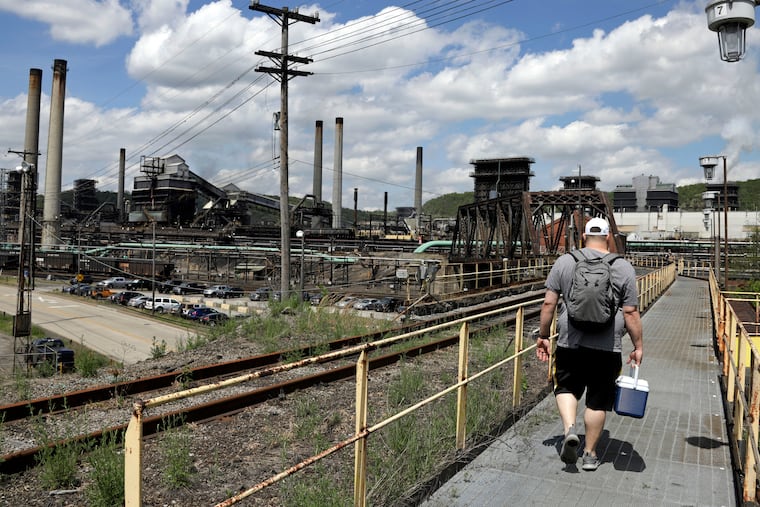U.S. Steel will have a hard time funding its new Pa. investments as global economy slows, Moody’s warns
Moody's has cut credit ratings for U.S. Steel, citing falling steel demand and rising debt

Moody’s Investors Service on Tuesday cut United States Steel Corp.'s credit rating a notch to B2 — “Highly Speculative” — on concerns that falling world steel demand, and the related drop in steel prices, are more likely to leave the second-largest American steelmaker unable to pay for recent investments in its plants in Pennsylvania and Eastern Europe.
Moody’s also reduced the Pittsburgh-based company’s unsecured-debt and environmental clean-up bonds another tick lower, to B3, one notch above “Substantial Risk” of default.
With “no impetus for material steel price improvement in the U.S., weak economic conditions in Europe are expected to persist,” along with weak demand for steel pipes, said senior vice president Carol Cowan in Moody’s report to bond investors.
President Donald Trump had made the revival of the U.S. steel industry a key measurement of his protectionist economic agenda, which has included tariffs on Asian, European, and Canadian steel, along with Navy shipbuilding and road-and-bridge-building programs featuring buy-American provisions that have not yet materialized two and a half years into his administration.
The increasingly automated steel industry is no longer a leading U.S. employer -- most members of the United Steelworkers union now labor in other industries -- but the health of its remaining plants is an important political symbol in several states, including Pennsylvania, which narrowly voted for Trump in 2016 and is a key to his re-election hopes in 2020.
Global steel giant ArcelorMittal has allowed its plate mill in Coatesville to age and has shut down most operations at its West Conshohocken mill instead of modernizing.
By contrast, U.S. Steel has gambled on expensive updates in hopes that global demand will continue to rise. As a result, the company’s debt-to-earnings ratio has zoomed to roughly double last year’s level as of June 30, with U.S. Steel debts now about five times higher than earnings (before financial costs), Moody’s added.
U.S. Steel’s Pennsylvania plants include a galvanizing plant near the site of the company’s long-closed Fairless Works in Bucks County north of Philadelphia, along with the larger Edgar Thompson steelworks in Braddock, the Irvin rolling mills in West Mifflin, and the Clairton coke (coal-based fuel) works. Those plants form the company’s Mon Valley complex in Southwestern Pennsylvania.
The bonds that Moody’s is downgrading, besides the company’s own debt, include municipal securities issued by the industrial development authorities of Bucks and Allegheny Counties, along with local governments around U.S. Steel plants in Illinois, Indiana, and Ohio, where officials hoped to keep those plants competitive at reduced borrowing costs.
U.S. Steel has committed $1.2 billion for the endless casting and rolling facility and a cogeneration facility at Mon Valley, $280 million for electric-tube furnace upgrades, and $130 million for the company’s Slovakia plant. Moody’s does not identify any funds going to the Bucks plant.
The company had been counting on nearly $400 million in new annual profits from these investments once they are completed in 2022.
Steel prices rose last year, boosting profits. But Moody’s expects “weaker” profits on lower prices in the second half of 2019 and in 2020.
“Steel prices have fallen steadily during 2019, with hot-rolled coil averaging $692 a ton in the quarter through March, $614 a ton for the quarter through June and we estimate that the third quarter will be around $580/$600 ton and not materially different over the next several quarters,” the Moody’s analysts noted.
Indeed, even as it ramps up for upgrades in the Pennsylvania plants, U.S. Steel has “temporarily idled two blast furnaces in the U.S. and one in Europe,” Moody’s added. “Key end markets such as automotive and [energy pipes] are slowing and industrial and machinery are expected to moderate, as well.”
And that’s still assuming the plant upgrades are finished on time and under budget.
Also, U.S. Steel, like its rivals, expects to face “pressure to reduce greenhouse gas and air pollution emissions, among a number of other sustainability issues.” That will push the company to continue converting its remaining coke-fired blast furnaces to electric heating while automakers shift away from steel toward aluminum.
The company’s cash hoard has been reduced, though it still has $651 million available as of June 30 and can probably renegotiate debt that starts coming due in 2023. So the company can endure a period of lower cash flow, so long as demand does not continue to drop.
U.S. Steel stock closed Tuesday at $10.68, down 3.5%, to its lowest price since 2016.